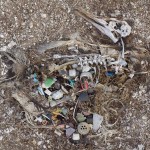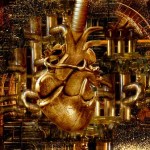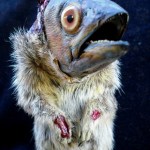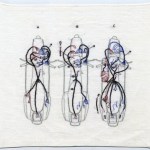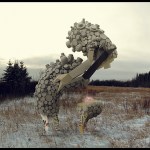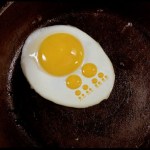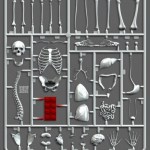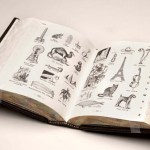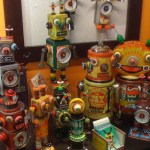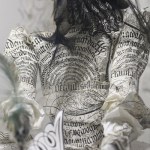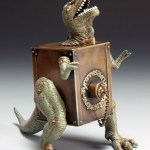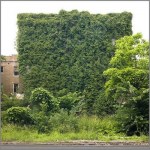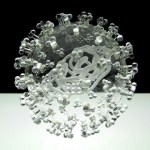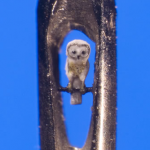Artists & Art
Heartbreaking photos of albatross chicks, by photographer Chris Jordan:
These photographs of albatross chicks were made just a few weeks ago on Midway Atoll, a tiny stretch of sand and coral near the middle of the North Pacific. The nesting babies are fed bellies-full of plastic by their parents, who soar out over the vast polluted ocean collecting what looks to them like food to bring back to their young. On this diet of human trash, every year tens of thousands of albatross chicks die on Midway from starvation, toxicity, and choking.To document this phenomenon as faithfully as possible,…
"Mechanical heart"
Bill McConkey
Collage of a digitally enhanced pencil drawing of the human heart and photographs of different brass instruments. Digital artwork. From the Wellcome Image Awards 2009 - see the other winners here.
Last week was Open Access Week, which meant I got to hear a great talk from John Wilbanks of the Science Commons (you should subscribe to their blog!) I've been thinking a lot this week about the legal challenges of data sharing, which is giving me a headache. But there's an easier way to celebrate Open Access Week: by visiting the Guardian's a multimedia show about…
Has your week been like this, too? I'm just checking. . .
"Fish in a squirrel suit" by Slightly Curious.
Via Regretsy.
To follow up on my post on Kevin Van Aelst, here's an anatomically-inspired artwork by Heather L. Johnson, whose new show, "Air and Blood", opens this month in NYC:
Using the Holland Tunnel as a point of departure, the artist investigates the way in which anatomical processes are mimicked in the transfer of people, objects and ideas in the urban environment.
I think that's a motorbike in that circulatory diagram - which of course invites comparison with the work of Josh Hadar.
For more on Johnson's new show, check out readymade blog.
From Inhabitat: Artist Brandon Jon Blommaert's recycled trash robots (yes, they're real sculptures) lay waste to Photoshopped landscapes. Check out his flickr page for more - and a "making of" series of photos showing how he built these steampunky robot overlords, who are destined for a Canadian recycling center. Their message is clear: RECYCLE, HUMANITY, OR BE EXTERMINATED!
Thanks to reader Todd F. for the heads-up!
Kantor Set
Kevin Van Aelst
Several readers have suggested I blog about photographer Kevin Van Aelst in the past weeks. If you've missed out on his work, Kevin is the sort of artist who can portray cellular mitosis in the legendarily difficult medium of Krispy Kreme, or chromosomes in gummi worm, fingerprints in non-dairy creamer, or the Kantor Set in egg yolk. His work is clever, funny, and meticulous to a fault.
Circulatory System (Heart On Your Sleeve), 2009
Kevin Van Aelst
Here's what the artist has to say:
While the depictions of information--such as an EKG, fingerprint, map or…
Cajal's Revenge, 2007
Katherine Sherwood
It's been a while since I've been able to focus on my Art vs. Science series of posts, so I understand if you've forgotten Part One and Part Two. A quick recap: in Part One, I asked,
I think that lay audiences approach scientific art differently - perhaps more credulously - than they do other forms of art, simply because lay audiences feel insecure and uncertain about basic science. Audiences may have so much respect for science, that they extend respect reflexively when science appears in other contexts - like art or entertainment. Anyone who's had…
Okay, everyone, here is something intriguing. The following video is amateurish, bizarre, has terrible production values, and appears to be the work of either a master performance artist or someone who lacks any self-consciousness whatsoever (shades of Little Edie Bouvier Beale).
But, if you start the video, then click over to some other window (go check your Gmail) and just listen to the audio without video, you're suddenly listening to a dusty, scratchy gramophone record that documents a forgotten, eccentric self-taught Appalachian folk musician from the turn of the century. Or something…
What You're Made Of (ABS)
Jason Freeny, 2009
Anatomy teachers: this would be an awesome quiz for your students, wouldn't it? :)
Jason Freeny is the digital artist behind Balloon Animal anatomy, Gummi Bear anatomy, and the dissected Gingerbread Man. Visit his site to see more! Via SheWalksSoftly.
Every time I move to a new home, I try really hard to get rid of all my extra stuff - or at least to put it in storage. But when it comes to books, I have no willpower. Regarding my ten-pound, 6-inch-wide, half-unbound early-twentieth century Funk & Wagnall's dictionary, there wasn't even a question: it goes with me where I go!
Do I use the thing to look up words? Rarely (although it's quite cool to see the early definitions of now-common scientific terms - they're often a little bit different than we might expect). Mostly, I love the pictures. Old dictionaries were works of art, with…
Artist Liz Hickok makes your Friday complete with a Jell-O San Francisco, from this jiggly Palace of Fine Arts to a melting Marina. Melding the blurry, children's book perspective of tilt-shift photography with the saturated, translucent colors that define the California dream, Hickok has hit on something remarkably luscious (and fruit-flavored).
Hickok says,
I create glowing, jellied scale models of urban sites, transforming ordinary physical surroundings into something unexpected and ephemeral. Lit from below, the molded shapes of the city blur into a jewel-like mosaic of luminous…
While delayed in the Denver airport last month, I discovered a large display of robots made of vintage tins, utensils, and knobs. They were the work of artist Mark Brown, who builds these comical, quizzical characters out of recycled and found materials. If we are ever exterminated by robot hordes, I hope they're this cute!
While the artist's website is rudimentary, you can find his work on the web, including at Uncommon Goods. The shop also carried a line of cute robot greeting cards for those (like me) who couldn't afford the $200 robot clocks; unfortunately I can't seem to find those on…
An enigmatic photo from Morbid Anatomy's review of the Quay Brothers show at Parsons in NYC. Read all about it here.
Okay, if you're anything like me, you don't have time to read the blogs you already follow. But I do recommend that everyone head over to SEED's Revolutionary Minds Think Tank, where Greg Smith is guiding a conversation on visualizing science.
That's where I found the video above, demonstrating the UCSD Software Studies Initiative's application of "cultural analytics" to Rothko's paintings. When the paintings are treated as data points over an artist's career, they can be compared and contrasted in untraditional ways, revealing new patterns and anomalies. Awesome find!
Here, Smith responds…
Tyrannosaurus photoventris
Judith Hoffman, 2009
This is just awesome! It's a dinocamera from artist/photographer/metalworker/amateur time traveler Judith Hoffman:
That's a lens cap/shutter on his navel. He takes pinhole photos of the late Cretaceous using paper negatives.
Here's one of the "photos of the Cretaceous:"
The realism is mind-boggling! I feel like I'm about to be devoured by a plastic toy on the set of a B-movie!
You can see more fun photos here, at Judith's site. She also has a show opening tomorrow at the Peninsula Art Museum, 10 Twin Pines Lane, Belmont, California 94002.…
"It will die, eventually, because no one will know how to do it." But for now, a few miles from here, Firefly Press' John Kristensen is keeping the tradition of letterpress alive, as seen in this beautiful video by Chuck Kraemer.
Via NOTCOT.
I previously blogged about Jennifer Angus' insect installation, Insecta Fantasia, in the Newark Museum's Victorian Ballantine House. For those of you who couldn't make it to the show this YouTube video is a wonderful tour.
Note the layered interplay of 2D wallpaper patterns with 3D insects - some of which have lasercut words and patterns cut into their carapaces - and the insect-populated dollhouses. An insect house within an insect house - it's the kind of intimate yet fantastic inner world created by the best children's books. I'm thrilled that this video lets everyone experience it.…
From the 8/31/09 New Yorker: "Still, she recognized that the aesthetic enjoyment of dereliction was a recondite and ultimately unsustainable pursuit."
Perhaps. I find these touching photos of Detroit's abandoned, overgrown houses from Sweet Juniper! disturbing because they are lush and lovely. Finding aesthetic beauty in a destroyed home, abandoned by the families that once lived there, symbol of unemployment and economic depression in a moribund once-community . . . it all seems horribly inappropriate. Yet there is a calm, timeless beauty in dereliction, isn't there? Perhaps it's a memento…
Via iO9, a gallery of stunning glass viruses by sculptor Luke Jerram, originally from the Guardian. (The one above is swine flu.)
The Science and Entertainment Exchange blog has an interesting post up about artist Willard Wigan, who creates sculptures that can only be seen through a microscope.
Wigan's story is touching - he started sculpting as a child, when his dyslexia made school a painful challenge. He says,
"I started making houses for ants because I thought they needed somewhere to live. Then I made them shoes and hats. It was a fantasy world I escaped to."
(That totally reminds me of the scene from Zoolander where the none-too-bright model played by Ben Stiller stares at a scale model of a proposed school…
